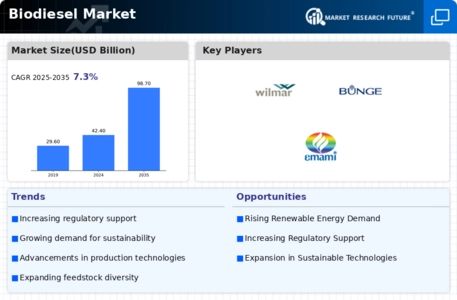-
EXECUTIVE’S HANDBOOK
-
The Top Performing Segments
-
Key Trends Summarized
-
Strategic Insights
-
Who are the Key Players in the Market?
-
SECTION II: SCOPING, METHODOLOGY AND MARKET STRUCTURE
-
MARKET INTRODUCTION
-
Definition
-
Report Segmentation & Scope
-
Regional & Country Level Coverage
-
Why you need this report?
-
RESEARCH METHODOLOGY
-
Research Process
-
Secondary Research
- Data Mining & Condensation
- Sources (Associations, Organizations, Magazines, Paid Databases)
-
Primary Research
- Sample Size (Demand-Supply, Company Type, Designations, Region)
- Sources
-
Factorial Analysis & Approach Setting
-
Estimation & Forecast Models
-
Pricing Baskets
-
Analyst Hours & Team
-
SECTION III: QUALITATIVE ANALYSIS
-
MARKET DYNAMICS
-
Introduction
-
Growth Parameters Mapped - Drivers
- Increasing demand for environment-friendly fuels
- Government support for biodiesel production
-
What are the challenges faced by Industry Participants?
- Production and efficiency constraints
-
Opportunities
- R&D towards product yield and efficiency
-
Regulatory Update
-
Impact Analysis of COVID-19
- Impact on Supply Chain of Biodiesel
- Impact on Market Demand of Biodiesel
-
MARKET FACTOR ANALYSIS
-
Supply/Value Chain Analysis
- Participants
- Value Percolation Across the Chain
- Integration Levels
- Key Issues Addressed
-
Porter’s Five Forces Model
- Bargaining Power of Suppliers
- Bargaining Power of Buyers
- Threat of New Entrants
- Threat of Substitutes
- Intensity of Rivalry
-
SECTION IV: QUANTITATIVE ANALYSIS
-
GLOBAL BIODIESEL MARKET, BY TYPE (USD MILLION)
-
Introduction
-
Methanol
- Global Biodiesel Market Size: Market Estimates & Forecast, By Methanol, 2018-2032
-
Biohydrogen
- Global Biodiesel Market Size: Market Estimates & Forecast, By Biohydrogen, 2018-2032
-
Cellulosic Ethanol
- Global Biodiesel Market Size: Market Estimates & Forecast, By Cellulosic Ethanol, 2018-2032
-
Others
- Global Biodiesel Market Size: Market Estimates & Forecast, By Others, 2018-2032
-
GLOBAL BIODIESEL MARKET, BY APPLICATION (USD MILLION)
-
Introduction
-
Power Generation
- Global Biodiesel Market Size: Market Estimates & Forecast, By Power Generation, 2018-2032
-
Transportation
- Global Biodiesel Market Size: Market Estimates & Forecast, By Transportation, 2018-2032
-
Others
- Global Biodiesel Market Size: Market Estimates & Forecast, By Others, 2018-2032
-
GLOBAL BIODIESEL MARKET, BY REGION (USD MILLION)
-
Introduction
-
North America
- North America Biodiesel Market Size: Market Estimates & Forecast, By Country, 2018-2032
- North America Biodiesel Market Size: Market Estimates & Forecast, By Type, 2018-2032
- North America Biodiesel Market Size: Market Estimates & Forecast, By Application, 2018-2032
- US
- Canada
- Mexico
-
Europe
- Europe Biodiesel Market Size: Market Estimates & Forecast, By Country, 2018-2032
- Europe Biodiesel Market Size: Market Estimates & Forecast, By Type, 2018-2032
- Europe Biodiesel Market Size: Market Estimates & Forecast, By Application, 2018-2032
- Germany
- France
- UK
- Spain
- Italy
- Rest of Europe
-
Asia-Pacific
- Asia-Pacific Biodiesel Market Size: Market Estimates & Forecast, By Country, 2018-2032
- Asia-Pacific Biodiesel Market Size: Market Estimates & Forecast, By Type, 2018-2032
- Asia-Pacific Biodiesel Market Size: Market Estimates & Forecast, By Application, 2018-2032
- China
- India
- Japan
- South Korea
- Rest of Asia-Pacific
-
Middle East & Africa
- Middle East & Africa Biodiesel Market Size: Market Estimates & Forecast, By Country, 2018-2032
- Middle East & Africa Biodiesel Market Size: Market Estimates & Forecast, By Type, 2018-2032
- Middle East & Africa Biodiesel Market Size: Market Estimates & Forecast, By Application, 2018-2032
- GCC Countries
- South Africa
- Rest of Middle East & Africa
-
South America
- South America Biodiesel Market Size: Market Estimates & Forecast, By Country, 2018-2032
- South America Biodiesel Market Size: Market Estimates & Forecast, By Type, 2018-2032
- South America Biodiesel Market Size: Market Estimates & Forecast, By Application, 2018-2032
- Brazil
- Argentina
- Rest of South America
-
SECTION V: COMPETITIVE ANALYSIS
-
COMPETITIVE LANDSCAPE
-
Introduction
-
Competition Dashboard
-
Company Market Share Analysis, 2023
-
Who are the market disruptors & innovators?
-
What strategies are being adopted by market leaders?
-
Competitive Benchmarking
-
The Leading Player in terms of Number of Developments in the Global Biodiesel Market
-
List of Key Players, By Region
-
Comparative Analysis: Key Players Financial
-
Key Developments & Growth Strategies
- New Product Launch/Service Deployment
- Merger & Acquisition
- Joint Ventures
-
COMPANY PROFILES
-
INEOS New Planet BioEnergy
- Company Overview
- Financial Overview
- Product Offered
- Key Developments
- SWOT Analysis
- Key Strategies
-
Cargill Inc.
- Company Overview
- Financial Overview
- Product Offered
- Key Developments
- SWOT Analysis
- Key Strategies
-
Abengoa
- Company Overview
- Financial Overview
- Product Offered
- Key Developments
- SWOT Analysis
- Key Strategies
-
Archer Daniels Midland Company
- Company Overview
- Financial Overview
- Product Offered
- Key Developments
- SWOT Analysis
- Key Strategies
-
Wilmar International Limited
- Company Overview
- Financial Overview
- Product Offered
- Key Developments
- SWOT Analysis
- Key Strategies
-
Bunge Limited
- Company Overview
- Financial Overview
- Product Offered
- Key Developments
- SWOT Analysis
- Key Strategies
-
Neste Corporation
- Company Overview
- Financial Overview
- Product Offered
- Key Developments
- SWOT Analysis
- Key Strategies
-
Emami Group
- Company Overview
- Financial Overview
- Product Offered
- Key Developments
- SWOT Analysis
- Key Strategies
-
Continental Refining Company
- Company Overview
- Financial Overview
- Product Offered
- Key Developments
- SWOT Analysis
- Key Strategies
-
BIOX Corporation
- Company Overview
- Financial Overview
- Product Offered
- Key Developments
- SWOT Analysis
- Key Strategies
-
RECOMMENDATIONS & EXPERT INSIGHTS
-
What is the short-term vs long-term outlook for Biodiesel Market?
-
Who are the players to look out for?
-
What will the product mix look in coming years?
-
MRFR OFFERINGS & TEAM
-
Citations & Media
-
Our Regional Representatives
-
Related Reports
-
Our Domain Coverage
-
NOTE:
-
This table of content is tentative and subject to change as the research progresses.
-
In section 10, each company will be profiled based on the Market Overview, Financials, Product Portfolio, Business Strategies, and Recent Developments parameters.
-
Please note: The financial details of the company cannot be provided if the information is not available in the public domain and or from reliable sources.
-
-
LIST OF TABLES
-
LIST OF ASSUMPTIONS
-
GLOBAL BIODIESEL MARKET ESTIMATES & FORECAST, BY TYPE, 2018-2032 (USD MILLION)
-
GLOBAL BIODIESEL MARKET ESTIMATES & FORECAST, BY APPLICATION, 2018-2032 (USD MILLION)
-
GLOBAL BIODIESEL MARKET, BY REGION, 2018-2032 (USD MILLION)
-
NORTH AMERICA: BIODIESEL MARKET, BY COUNTRY, 2018-2032 (USD MILLION)
-
NORTH AMERICA: BIODIESEL MARKET, BY TYPE, 2018-2032 (USD MILLION)
-
NORTH AMERICA: BIODIESEL MARKET, BY APPLICATION, 2018-2032 (USD MILLION
-
U.S.: BIODIESEL MARKET, BY TYPE, 2018-2032 (USD MILLION)
-
U.S.: BIODIESEL MARKET, BY APPLICATION, 2018-2032 (USD MILLION)
-
CANADA: BIODIESEL MARKET, BY TYPE, 2018-2032 (USD MILLION)
-
CANADA: BIODIESEL MARKET, BY APPLICATION, 2018-2032 (USD MILLION)
-
MEXICO: BIODIESEL MARKET, BY TYPE, 2018-2032 (USD MILLION)
-
MEXICO: BIODIESEL MARKET, BY APPLICATION, 2018-2032 (USD MILLION)
-
EUROPE: BIODIESEL MARKET, BY COUNTRY, 2018-2032 (USD MILLION)
-
EUROPE: BIODIESEL MARKET, BY TYPE, 2018-2032 (USD MILLION)
-
EUROPE: BIODIESEL MARKET, BY APPLICATION, 2018-2032 (USD MILLION)
-
GERMANY: BIODIESEL MARKET, BY TYPE, 2018-2032 (USD MILLION)
-
GERMANY: BIODIESEL MARKET, BY APPLICATION, 2018-2032 (USD MILLION)
-
FRANCE: BIODIESEL MARKET, BY TYPE, 2018-2032 (USD MILLION)
-
FRANCE: BIODIESEL MARKET, BY APPLICATION, 2018-2032 (USD MILLION)
-
UK: BIODIESEL MARKET, BY TYPE, 2018-2032 (USD MILLION)
-
UK: BIODIESEL MARKET, BY APPLICATION, 2018-2032 (USD MILLION)
-
SPAIN: BIODIESEL MARKET, BY TYPE, 2018-2032 (USD MILLION)
-
SPAIN: BIODIESEL MARKET, BY APPLICATION, 2018-2032 (USD MILLION)
-
ITALY: BIODIESEL MARKET, BY TYPE, 2018-2032 (USD MILLION)
-
ITALY: BIODIESEL MARKET, BY APPLICATION, 2018-2032 (USD MILLION)
-
REST OF EUROPE: BIODIESEL MARKET, BY COUNTRY, 2018-2032 (USD MILLION)
-
REST OF EUROPE: BIODIESEL MARKET, BY TYPE, 2018-2032 (USD MILLION)
-
REST OF EUROPE: BIODIESEL MARKET, BY APPLICATION, 2018-2032 (USD MILLION)
-
ASIA PACIFIC: BIODIESEL MARKET, BY COUNTRY, 2018-2032 (USD MILLION)
-
ASIA PACIFIC: BIODIESEL MARKET, BY TYPE, 2018-2032 (USD MILLION)
-
ASIA PACIFIC: BIODIESEL MARKET, BY APPLICATION, 2018-2032 (USD MILLION)
-
CHINA: BIODIESEL MARKET, BY TYPE, 2018-2032 (USD MILLION)
-
CHINA: BIODIESEL MARKET, BY APPLICATION, 2018-2032 (USD MILLION)
-
INDIA: BIODIESEL MARKET, BY TYPE, 2018-2032 (USD MILLION)
-
INDIA: BIODIESEL MARKET, BY APPLICATION, 2018-2032 (USD MILLION)
-
JAPAN: BIODIESEL MARKET, BY TYPE, 2018-2032 (USD MILLION)
-
JAPAN: BIODIESEL MARKET, BY APPLICATION, 2018-2032 (USD MILLION)
-
SOUTH KOREA: BIODIESEL MARKET, BY TYPE, 2018-2032 (USD MILLION)
-
SOUTH KOREA: BIODIESEL MARKET, BY APPLICATION, 2018-2032 (USD MILLION)
-
REST OF ASIA PACIFIC: BIODIESEL MARKET, BY COUNTRY, 2018-2032 (USD MILLION)
-
REST OF ASIA PACIFIC: BIODIESEL MARKET, BY TYPE, 2018-2032 (USD MILLION)
-
REST OF ASIA PACIFIC: BIODIESEL MARKET, BY APPLICATION, 2018-2032 (USD MILLION)
-
MIDDLE EAST & AFRICA: BIODIESEL MARKET, BY COUNTRY, 2018-2032 (USD MILLION)
-
MIDDLE EAST & AFRICA: BIODIESEL MARKET, BY TYPE, 2018-2032 (USD MILLION)
-
MIDDLE EAST & AFRICA: BIODIESEL MARKET, BY APPLICATION, 2018-2032 (USD MILLION)
-
GCC COUNTRIES: BIODIESEL MARKET, BY TYPE, 2018-2032 (USD MILLION)
-
GCC COUNTRIES: BIODIESEL MARKET, BY APPLICATION, 2018-2032 (USD MILLION)
-
SOUTH AFRICA: BIODIESEL MARKET, BY TYPE, 2018-2032 (USD MILLION)
-
SOUTH AFRICA: BIODIESEL MARKET, BY APPLICATION, 2018-2032 (USD MILLION)
-
REST OF MIDDLE EAST & AFRICA: BIODIESEL MARKET, BY COUNTRY, 2018-2032 (USD MILLION)
-
REST OF MIDDLE EAST & AFRICA: BIODIESEL MARKET, BY TYPE, 2018-2032 (USD MILLION)
-
REST OF MIDDLE EAST & AFRICA: BIODIESEL MARKET, BY APPLICATION, 2018-2032 (USD MILLION)
-
SOUTH AMERICA: BIODIESEL MARKET, BY COUNTRY, 2018-2032 (USD MILLION)
-
SOUTH AMERICA: BIODIESEL MARKET, BY TYPE, 2018-2032 (USD MILLION)
-
SOUTH AMERICA: BIODIESEL MARKET, BY APPLICATION, 2018-2032 (USD MILLION)
-
BRAZIL: BIODIESEL MARKET, BY TYPE, 2018-2032 (USD MILLION)
-
BRAZIL: BIODIESEL MARKET, BY APPLICATION, 2018-2032 (USD MILLION)
-
ARGENTINA: BIODIESEL MARKET, BY TYPE, 2018-2032 (USD MILLION)
-
ARGENTINA: BIODIESEL MARKET, BY APPLICATION, 2018-2032 (USD MILLION)
-
REST OF SOUTH AMERICA: BIODIESEL MARKET, BY COUNTRY, 2018-2032 (USD MILLION)
-
REST OF SOUTH AMERICA: BIODIESEL MARKET, BY TYPE, 2018-2032 (USD MILLION)
-
REST OF SOUTH AMERICA: BIODIESEL MARKET, BY APPLICATION, 2018-2032 (USD MILLION)
-
-
LIST OF FIGURES
-
MARKET SYNOPSIS
-
MARKET ATTRACTIVENESS ANALYSIS: GLOBAL BIODIESEL MARKET
-
GLOBAL BIODIESEL MARKET ANALYSIS BY TYPE
-
GLOBAL BIODIESEL MARKET ANALYSIS BY APPLICATION
-
GLOBAL BIODIESEL MARKET ANALYSIS BY REGION
-
GLOBAL BIODIESEL MARKET: MARKET STRUCTURE
-
KEY BUYING CRITERIA OF BIODIESEL
-
RESEARCH PROCESS OF MRFR
-
NORTH AMERICA MARKET SIZE & MARKET SHARE BY COUNTRY (2024 VS 2032)
-
EUROPE MARKET SIZE & MARKET SHARE BY COUNTRY (2024 VS 2032)
-
ASIA-PACIFIC & MARKET SHARE BY COUNTRY (2024 VS 2032)
-
MIDDLE EAST & AFRICA MARKET SIZE & MARKET SHARE BY COUNTRY (2024 VS 2032)
-
SOUTH AMERICA MARKET SIZE & MARKET SHARE BY COUNTRY (2024 VS 2032)
-
DROC ANALYSIS OF GLOBAL BIODIESEL MARKET
-
DRIVERS IMPACT ANALYSIS: BIODIESEL MARKET
-
RESTRAINTS IMPACT ANALYSIS: BIODIESEL MARKET
-
SUPPLY / VALUE CHAIN: GLOBAL BIODIESEL MARKET
-
GLOBAL BIODIESEL MARKET, BY TYPE, 2023 (% SHARE)
-
GLOBAL BIODIESEL MARKET, BY TYPE, 2024 TO 2032 (USD MILLION)
-
GLOBAL BIODIESEL MARKET, BY APPLICATION, 2023 (% SHARE)
-
GLOBAL BIODIESEL MARKET, BY APPLICATION, 2024 TO 2032 (USD MILLION)









Leave a Comment